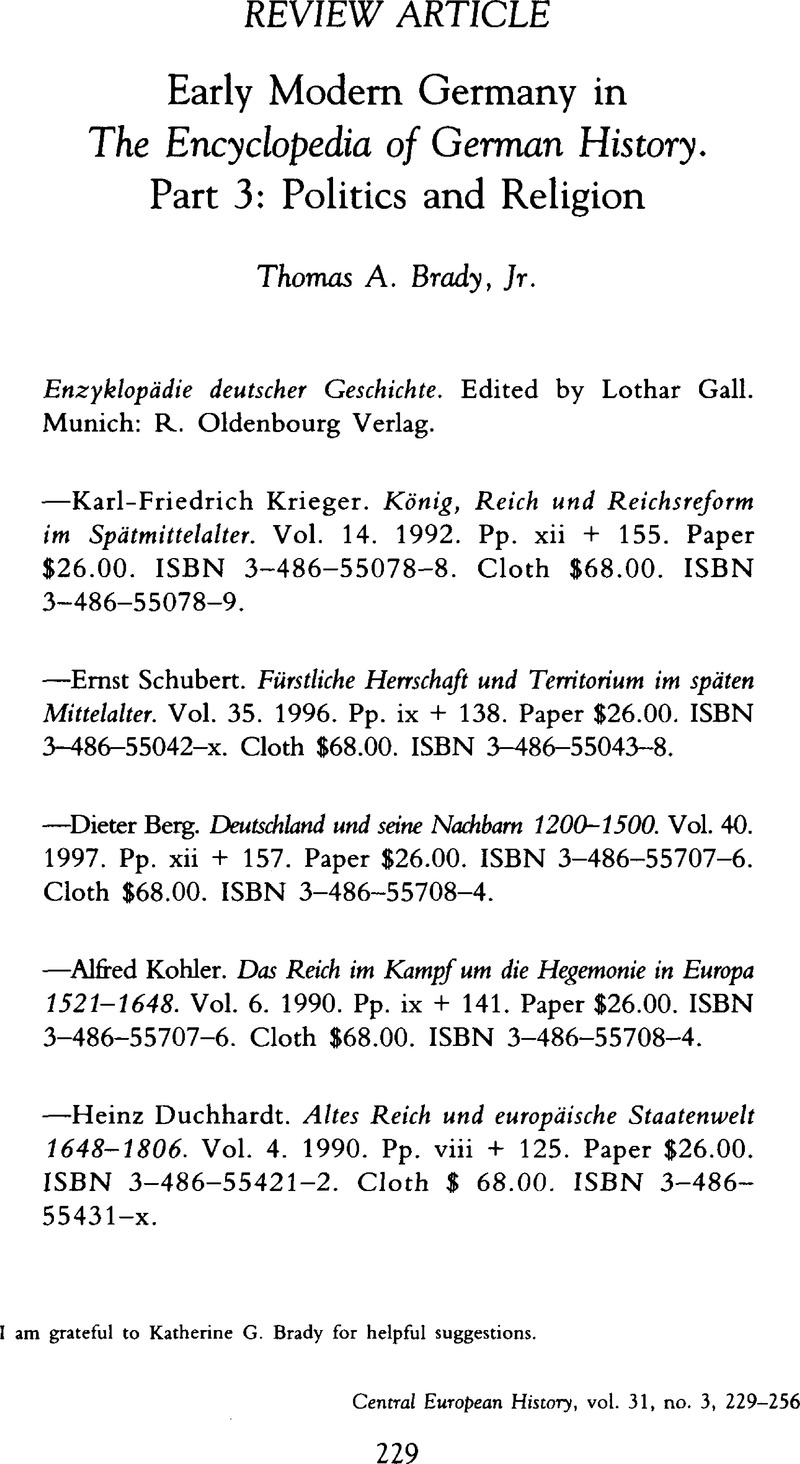No CrossRef data available.
Published online by Cambridge University Press: 16 December 2008

1. Krieger, 11.
2. Ibid., 38–39.
3. Brunner, Otto, Land und Herrschaft (1939);Google Scholar in English as Land and Lordship: Structures of Governance in Medieval Austria, trans. Kaminsky, Howard and Van Horn Melton, James (Philadelphia, 1992).Google Scholar See my evaluation in “Whose Land? Whose Lordship? The New Translation of Otto Brunner,” Central European History 29 (1996): 227–34.CrossRefGoogle Scholar
4. Krieger, 57.
5. Peter Moraw, quoted by Krieger, 104.
6. Schubert, 5.
7. Ibid., 7.
8. Ibid., 14.
9. Ibid., 49.
10. Quoted by Schubert, 52.
11. Ibid., 61.
12. Quoted by Schubert, 77.
13. Schubert, 95.
14. Ibid., 106.
15. It complements his more general introduction to late medieval German history, Einführung in die Grundprobleme der deutschen Geschichte im Spätmittelalter (Darmstadt, 1992).Google Scholar
16. Berg, xi.
17. Ibid.
18. Ibid., 1.
19. Ibid., 47.
20. Quoted by Berg, 48.
21. Kohler, xi. The volume is dedicated to Heinrich Lutz.
22. Ibid., 1.
23. Ibid., 2.
24. Which Kohler uncritically accepts, much as Hermann Wiesflecker did with Maximilian, as a medieval survival.
25. Duchhardt, 32.
26. Ibid., 64.
27. Schmidt, xi.
28. Ibid.
29. And as an orientation to Schindling, Anton and Ziegler, Walter, eds., Die Territorien des Reichs im Zeitalter der Reformation und Konfessionalisierung: Land und Konfession 1500–1650, 5 vols.,Google ScholarKatholisches Leben und Kirchenreform im Zeitalter der Glaubensspaltung, vols. 49–53 (Münster, 1989–1993).Google Scholar
30. Jedin, Hubert, Latourette, Kenneth Scott, and Martin, J., eds., Atlas zur Kirchengeschichte, rev. ed. (Freiburg im Breisgau, 1987 [1970]), 74, 75.Google Scholar
31. Schmidt, 55.
32. Schilling, Heinz, ed., Die reformierte Konfessionalisierung in Deutschland—Das Problem der “Zweiten Reformation”. Wissenschaftliches Symposium des Vereins für Reformationsgeschichte, Schriften des Vereins für Reformationsgeschichte, no. 195 (Gütersloh, 1986);Google ScholarRublack, Hans-Christoph, ed., Die lutherische Konfessionalisierung in Deutschland. Wissenschaftliches Symposium des Vereins für Reformationsgeschichte, Schriften des Vereins für Reformationsgeschichte, no. 197 (Gütersloh, 1992);Google ScholarReinhard, Wolfgang and Schilling, Heinz, eds., Die katholische Konfessionalisierung: Akten eines von Corpus Catholicorum und Verein für Reformationsgeschichte veranstalteten Symposions, Augsburg, 1993, Reformationsgeschichtliche Studien und Texte, no. 153 (Gütersloh and Münster, 1995).Google Scholar
33. This concept underlies much of the American work on German rural history, notably by David Sabean, Thomas Robisheaux, Hermann Rebel, Marc Forster, and John Theibault. It is gradually penetrating the German-language writing on rural history. See my comments on Werner Trossbach’s Bauern 1648–1806, in the first part of this review essay.
34. Schindling, 2.
35. Ibid., 48.
36. Ibid., 49.
37. Ibid., 99.
38. Ibid., 101.
39. It may therefore well be that this and certain other characteristics—the “new monarchies,” overseas empire—should be demoted from marks of European history to marks of Western European history. See my reflections on this subject in my study, “The Rise of Merchant Empires, 1400–1700: A European Counterpoint,” in The Political Economy of Merchant Empires, 1450–1750, ed. Tracy, James D.Cambridge, 1991), 117–60.CrossRefGoogle Scholar On the problems of periodization more generally, see “Introduction: Renaissance and Reformation, Late Middle Ages and Early Modern Era,” in Handbook of European History, 1400–1600: Late Middle Ages, Renaissance, Reformation, ed. Brady, Thomas A. Jr, Oberman, Heiko A., and Tracy, James D., 2 vols. (Leiden, 1974–1975), 1:xiii–xxiv.Google Scholar
40. See Bernd Moeller’s contribution to Berndt Hamm, Moeller, Bernd, and Wendebourg, Dorothea, Reformationstheorien: Ein kirchenhistorischer Disput über Einheit und Vielfalt der Reformation (Göttingen, 1995).Google Scholar
41. Romuald, Bauerreiss O.S.B., Kirchengeschichte Bayerns, vol. 6: Das sechzehnte Jahrhundert (St. Ottilien, 1965), 282.Google Scholar